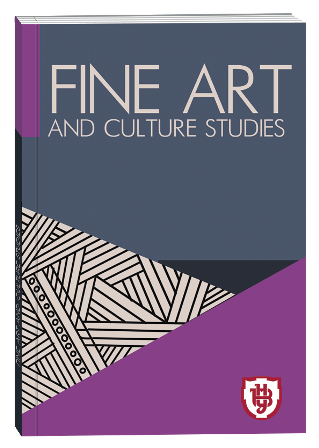SUITE G DUR BY SYLVIUS LEOPOLD WEISS ARRANGED FOR BANDURA: HISTORICAL, THEORETICAL, METHODOLOGICAL AND PERFORMANCE ASPECTS
DOI:
https://doi.org/10.32782/facs-2024-1-13Keywords:
bandura, lute music, baroque, expressive techniques, style, arrangement, prélude non mesuré, Weiss.Abstract
The aim of the study is to reveal the peculiarities of the arrangement of Baroque lute music for bandura on the example of the Suite in G-dur by Sylvius Leopold Weiss. The milestones of the composer's life and creative path and the expressive means inherent in the composer are outlined. The methodology of the study is manifested in the use of historical-theoretical, musical-textual, and empirical methods of analysis. The issues of deciphering tablatures, as well as the problems of interpreting lute works and their arrangements for bandura have received very little attention in the national scientific field. Therefore, the scientific novelty of this study is that for the first time in Ukrainian musicology: 1) the regularities and parameters of deciphering the French tablature have been identified; 2) an analysis of an exemplary lute work of the Baroque period, namely the Suite in G-dur by Sylvius Leopold Weiss, has been carried out; 3) the peculiarities of arrangements of lute works for bandura have been highlighted. For the first time, the arrangement of lute works for bandura is considered as a separate phenomenon. Conclusions. The article describes the creative path and peculiarities of the musical language of Sylvius Leopold Weiss. It is noted that the following parameters are necessary for the translation and interpretation of his works on bandura: understanding of the composer's style, knowledge of the peculiarities of deciphering the French tablature, the ability to read the generally accepted articulation, ornamental, fingering notation in the musical text and Weiss's author's marks, as well as understanding the context of the era. The analysis of each movement of the Suite in G dur by S. L. Weiss shows that this is a cycle based on the principle of contrasting types of presentation, as well as on the comparison of figurative, tempo, and textural solutions. A detailed analysis of the prélude non mesuré (non-melodic prelude) points to the peculiarities of the rhythmic interpretation of this genre and improvisation. To overcome the performance difficulties for the bandura arrangement of the original work, it is necessary to pay attention to smooth vocalisation during the transition of melodic lines from the right-hand part to the left-hand part and vice versa, fingering solutions when performing decorations, the tempo of different parts of the cycle and agogic deviations. It is the careful mastery of the elements of the performance skills of musicians of the seventeenth and eighteenth centuries, the accumulation of considerable experience in deciphering and performing various ornaments and understanding their artistic role, as well as subordination of the technical side of performing baroque lute music to its expressive nature that are the main tasks that arise on the way to free mastery of the style of performing baroque lute music, opening up new horizons for bandura players in the formation of pedagogical and concert repertoire.
References
Сторонянська М.-М. В. Специфіка перекладення та інтерпретації французької лютневої музики епохи бароко для бандури. Науковий збірник Українська культура: минуле, сучасне, шляхи розвитку № 46. Рівне, 2023. С. 198–205.
Щадріна-Личак О.В. Клавесинна безтактова прелюдія у сучасному історично орієнтованому виконавстві. Науковий журнал Національної музичної академії України імені П. І. Чайковського № 3 (8). Київ, 2010. С. 150–159.
Baron E. G. Study of the Lute / Translation to English A. Douglas Smith. 2019. Independently published. 212 р.
Beghin T. The Virtual Haydn: Paradox of a Twenty-First-Century Keyboardist. The University of Chicago Press. 2015. 60 р.
Couperin F. Art of Playing the Harpsichord. USA: Alfred Publishing Company. 2008. 84 p.
Croton P. Performing Baroque Music on the Classical Guitar: A Practical Handbook Based on Historical Sources. CreateSpace Independent Publishing Platform. 2015. 239 р.
Die Briefentwürfe des Johan Elias Bach (1705–1755): Herausgegeben und kommentiert von Evelin Odrich und Peter Wollny. Mit Beiträgen zum Leben und ... (Leipziger Beiträge zur Bachforschung). – Georg Olms Verlag; 2., erweiterte Aufl. 2005 edition. 288 р.
Dolmetsch A. The Interpretation of the Music of the XVIIth and XVIII centuries. London : Novello and Company, 1915. 493 р.
Gustafson B. The Art of the Unmeasured Prelude for Harpsichord: France 1660–1720 by Colin Tilney. Music & Letters 74, № 4. 1993. 648 р.
Ledbetter D. Harpsichord and Lute Music in 17th Century France. London: Macmillan, 1987. 194 p.
Ledbetter D., & Ferguson H. Prelude. Grove Music Online, 2001. Retrieved 20 Mar. 2023, from https://www. oxfordmusiconline.com/grovemusic/view/10.1093/gmo/9781561592630.001.0001/omo-9781561592630-e-0000043302.
Moroney D. Prélude non mesuré. Grove Music Online, 2001. Retrieved 20 Mar. 2023. URL: https://www.
oxfordmusiconline.com/grovemusic/view/10.1093/gmo/9781561592630.001.0001/omo-9781561592630-e-0000022290.
Munoz S. Guidelines for Transcribing Baroque Lute Music for the Modern Guitar, Using Silvius Leopold Weiss's Sonata. PhD diss. Arizona University. 2016. 128 р.
Neumann Frederick, Ornamentation in Baroque and Post-Baroque Music: With Special Emphasis on J. S. Bach. Princeton: Princeton University Press, 1978. 626 p.
Smith D.A. The Late Sonatas of Silvius Leopold Weiss. PhD diss. Stanford University. 1977. 540 р.
Spitzer J. and Zaslaw N. Improvised Ornamentation in Eighteenth-Century Orchestras. Journal of the American Musicological Society 39, № 3. 1986. 533 р.
Tilney C. The Art of the Unmeasured Prelude for Harpsichord: France 1660-1720. London: Schott & Co., 1991. 62 p.







